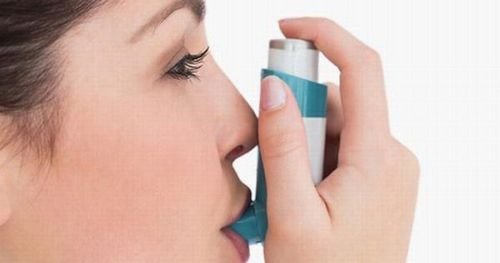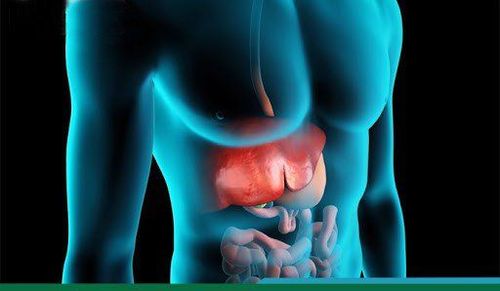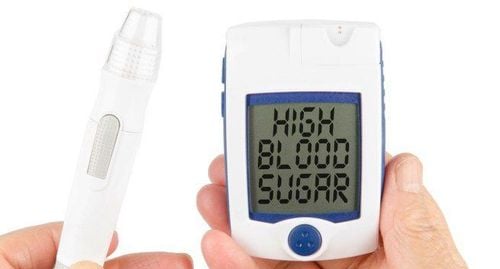This is an automatically translated article.
The article was professionally consulted by Specialist Doctor I Nguyen Hong Phuc - Emergency Department - Vinmec Phu Quoc International General Hospital. The doctor has many years of experience in the treatment of respiratory medicine.Shortness of breath is not a disease, it is a common symptom associated with a serious health problem. This manifestation can be acute or chronic. Finding out the cause of shortness of breath will help you have appropriate and effective treatment methods.
1. Pneumonia
Pneumonia represents a form of lung infection. Microorganisms such as bacteria, viruses or fungi can be the cause of the disease. Pneumonia can adversely affect the patient's life. Children under 2 years of age and adults over 65 are both more likely to have a more severe condition. People who smoke or abuse alcohol are at a higher risk of developing pneumonia.Symptoms of pneumonia include cough, shortness of breath, fever, shortness of breath, fatigue, chest pain, nausea and diarrhea. Along with that are complications such as lung abscess, bacteria in the blood, or pleural effusion.
2. Asthma
Asthma is a chronic form of lung caused by inflammation and narrowing of the airways. Inflammation of the airways causes mucus to be produced. The severity of asthma can be classified as intermittent, mild, intermittent, or severe.Symptoms include coughing, shortness of breath, wheezing and shortness of breath. There is no way to completely treat asthma, but it can be effectively controlled with medication.

3. Chronic Obstructive Pulmonary Disease
Chronic obstructive pulmonary disease or COPD is a progressive form of lung disease. COPD makes it difficult for air to get in and out of the lungs.Symptoms of COPD can include coughing with large amounts of mucus, shortness of breath, shortness of breath, wheezing, fatigue, and weight loss. Severely ill people can be treated through lung volume reduction surgery or lung transplantation.
4. Lung cancer
Lung cancer is an uncontrolled growth of abnormal cells in lung tissue. It is the leading cause of death from cancer. There are two main types of lung cancer: non-small cell lung cancer and small cell lung cancer. Small cells are the major cause of lung cancer (about 85%), pancreatic cancer, and squamous cell carcinoma. Prostate cancer is also among the most common forms of the disease.Symptoms of lung cancer can include shortness of breath, shortness of breath, persistent cough, wheezing, shortness of breath, chest pain, hoarseness, coughing up blood, bone pain, and weight loss. Treatment may include one or more options such as surgery, chemotherapy, or radiation.
5. Pneumothorax
This is a symptom related to the abnormal appearance of air between the lungs and pleura. This condition causes partial or complete loss of function in the lungs. Pneumothorax can be caused by chest trauma (necrotic or stabbing), lung disease, or breathing aids. Smokers and people diagnosed with chronic obstructive pulmonary disease (COPD) or immunodeficiency syndrome (AIDS) are at increased risk of experiencing a pneumothorax.Symptoms of a pneumothorax can include shortness of breath, heavy sweating, and sudden chest pain. Individuals diagnosed with pneumothorax should avoid flying or deep diving until the illness clears up.
6. Pulmonary embolism
Pulmonary embolism refers to a condition in which blood clots in the lungs and blocks a pulmonary artery. The main cause of pulmonary embolism is deep vein thrombosis. Factors that increase the risk for developing pulmonary embolism include cancer, hip or leg fractures, and obesity.Symptoms of pulmonary embolism may include shortness of breath, anxiety, chest pain, coughing up blood, and calf swelling. Pulmonary embolism can be life-threatening and is considered dangerous.
7. Anemia
Anemia is a prominent cause of dyspnea when hemoglobin levels fall below 8-10 g/dl. If hemoglobin continues to drop, shortness of breath will become more pronounced. This association is most pronounced in acute anemia. Multiple compensatory mechanisms will make the shortness of breath in chronic ischemic patients less obvious.Anemia is caused by a lack of normal red blood cells in the blood. The bleeding, reduced blood production can cause a shortage of red blood cells. The function of red blood cells is to carry oxygen to the cells and tissues of the body. The effects of anemia can range from mild to severe. Iron deficiency anemia is the most common type.
Symptoms of anemia may include shortness of breath, shortness of breath, fatigue, dizziness, pale skin, and chest pain. The disease has many causes including bleeding, malnutrition, iron deficiency, kidney disease and genetic disorders. Anemia is easily treatable, but it can also be fatal if not taken care of properly.

8. Cardiovascular disease
Cardiovascular disease is a prominent cause of shortness of breath. In many cases, the underlying disease is quite pronounced, as in pulmonary edema or acute myocardial infarction. In other situations, the cause may be less obvious, as is the case with an atrial septal defect or early-stage mitral stenosis. Especially in patients with diabetes, myocardial ischemia due to coronary artery disease may present with intermittent episodes of dyspnea without chest pain.Chronic heart failure is a complex cause of dyspnea, as patient complaints are often slow to resolve even after relatively adequate treatment. In these cases, the physician needs to re-evaluate the effectiveness of treatment and look for other causes such as anemia or pulmonary infarction. Shortness of breath is one of the symptoms of patients with chronic heart failure.
9. Generalized Anxiety Disorder
Generalized anxiety disorder is a mental illness. The disease is common in the 30-40 years old, more women than men. The disease is characterized by anxiety or worry that is constant and frequently interferes with activities of daily living.Patients with psychogenic dyspnoea often present with severe anxiety and hyperventilation symptoms and complain of visual disturbances, dizziness, fainting, numbness, and stinging around the mouth and fingers. Symptoms of generalized anxiety disorder can be excessive anxiety, shortness of breath, irritability, fatigue, trouble sleeping, nausea, vomiting, and diarrhea.
10. Pleurisy
Pleurisy, also known as pneumonia, refers to a condition in which there is a double membrane lining the inside of the chest cavity and around the lungs. Other causes of pleurisy include infection, cancer, congestive heart failure, pulmonary embolism, certain medications, pneumothorax, and autoimmune diseases (rheumatoid arthritis, lupus). .A common complication is the accumulation of excess fluid between the layers of the pleura, called a pleural effusion. The main symptoms of pleurisy are shortness of breath, chest pain when breathing, shortness of breath, cough, fever, and shoulder or back pain.
11. Granuloma
Granulomatosis is the growth of clusters of inflammatory cells in various organs of the human body. The disease can affect anywhere but most often affects the lungs. The cause of granulomas is still unknown, but researchers believe it may be the body's immune system's response to a foreign substance. Risk factors that increase the likelihood of developing granulomas include being female and having a family history.Symptoms of granulomas are cough, shortness of breath, shortness of breath, wheezing, fever, fatigue, weight loss, joint pain, skin rash, chest pain, seizures, and loss of vision.
12. Tuberculosis
Tuberculosis is a very contagious disease that mainly affects the lungs. Tuberculosis cases may experience symptoms such as fever, fatigue, shortness of breath, coughing up blood, night sweats, and weight loss.The agents that cause respiratory diseases are all around us. Therefore, if you have any abnormal symptoms in breathing, you should see a doctor immediately for timely diagnosis and treatment.
Shortness of breath is the most common symptom when dealing with cases of cardiopulmonary disease. This symptom is completely subjective and fickle. With a subtle, step-by-step approach, starting with a thorough history and physical examination and appropriate laboratory tests to examine, will lead to the correct diagnosis in most cases. Unexplained dyspnea following routine evaluation should be referred to a specialist.
If there is a need for consultation and examination at the Hospitals of the National Health System, please book an appointment directly on the website for the best service.
Please dial HOTLINE for more information or register for an appointment HERE. Download MyVinmec app to make appointments faster and to manage your bookings easily.














